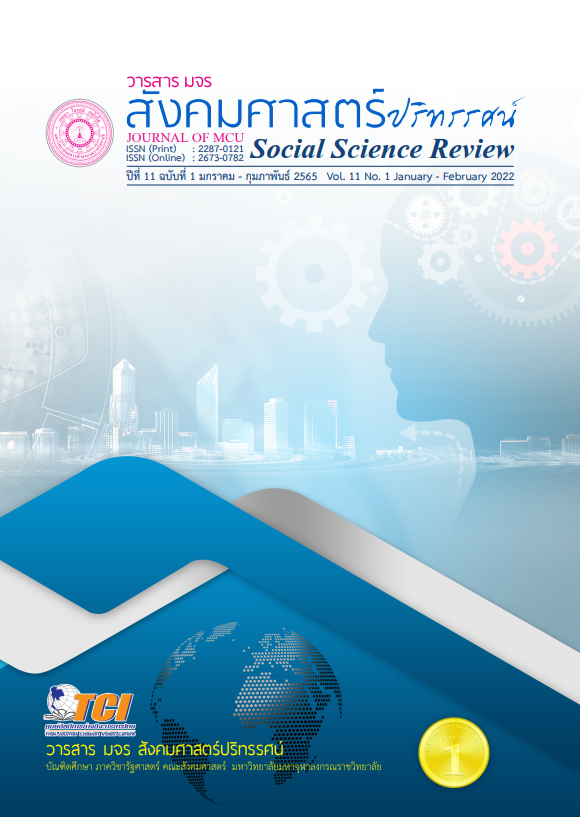การสร้างความสุขในการทำงานยุค NEW NORMAL
คำสำคัญ:
การสร้างความสุข, การทำงาน, ยุค New Normalบทคัดย่อ
บทความวิชาการเรื่อง การสร้างความสุขในการทำงานยุค New Normal เป็นการนำเสนอหลักการสร้างความสุขในการทำงานตามหลักจิตวิทยา และความสุขตามหลักพระพุทธศาสนา โดยมีดัชนีชี้วัดระดับของความสุขบนพื้นฐานของการทำงาน ซึ่งการสร้างความสุขในการทำงานขององค์กรนั้น มีความพึงพอใจในชีวิต ความพึงพอใจในงาน อารมณ์ทางบวก อารมณ์ทางลบ ผ่านความมีอิสระการทำงาน ความรู้ ความสามารถ เป็นลักษณะเฉพาะตัวของแต่ละบุคคล เพื่อส่งเสริมให้เกิดวิสัยทัศน์ และเสริมสร้างประสบการณ์ในการทำงานอย่างมีความสุข
ดังนั้น การทำงานในชีวิตประจำวันต้องมีความพอใจในสิ่งที่ตนทำ พอใจในงานที่กระทำอยู่ และสามารถควบคุมอารมณ์ต่างๆ ที่เข้ามากระทบ ไม่ว่าจะเป็นอารมณ์ทางบวก หรืออารมณ์ทางลบ สามารถบริหารจัดการอารมณ์เหล่านี้ได้อย่างเป็นระบบ และไม่กระทบต่องานที่ทำ จนทำให้ผลสัมฤทธิ์ของงานออกมาอย่างมีคุณภาพ
เอกสารอ้างอิง
เจริญชัย เพ็งสว่าง. (2553). ความสัมพันธ์ระหว่างปัจจัยส่วนบุคคล การได้รับการเสริมสร้างพลังอำนาจในงานแรงจูงใจใฝ่สัมฤทธิ์กับความสุขในการทำงานของพยาบาลประจำการโรงพยาบาลมหาวิทยาลัยของรัฐ (วิทยานิพนธ์พยาบาลศาสตรมหาบัณฑิต สาขาวิชาการพยาบาล). กรุงเทพฯ: จุฬาลงกรณ์มหาวิทยาลัย.
ฉันทนา ภาคบงกช. (2544). การอบรมเลี้ยงดูเพื่อเสริมสร้างความสุข. พฤติกรรมศาสตร์, 7(1), 27-34.
นภดล กรรณิกา และคณะ. (2564). รายงานดัชนีความสุขมวลรวมของประชาชนภายในประเทศในช่วงเดือนพฤษภาคม - กรกฎาคม 2550. สืบค้น 20 เมษายน 2564, จากhttp//www.abacpoll.au.edu/subresearch/happiness/ research_paper/pdf/2007/ABAC_POOL_Social_ Innovation_Gross_ Happiness_Jan_2007.pdf
ปรีดาภรณ์ ศุทธิเวทิน. (2564). ความสุขในการทำงานของบุคลากรส่วนกลางกรมส่งเสริมสหกรณ์. สืบค้น 20 เมษายน 2564, จากhttps://mmm.ru.ac.th/ MMM/IS/twin-7/6114152029.pdf
พระมหาวิเชียร สุธีโร. (2562). ความสุขในทัศนะของพระพุทธศาสนา. วารสารพุทธมัคค์ ศูนย์วิจัยธรรมศึกษา สำนักเรียนวัดอาวุธวิกสิตาราม, 4(1), 44-45.
พระมหาสุทิตย์ อาภากโร และเขมณัฏฐ์ อินทรสุวรรณ. (2553). ตัวชี้วัดความสุข: กลยุทธ์การสร้างและการใช้เพื่อชุมชนเป็นสุข. กรุงเทพฯ: โครงการเสริมสร้างการเรียนรู้เพื่อชุมชนเป็นสุข.
พระมหาสุทิตย์ อาภากโร และคณะ. (2558). การสร้างและพัฒนาตัวชี้วัดความสุขของประชาชนตามหลักคำสอนของพระพุทธศาสนา. พระนครศรีอยุธยา: สถาบันวิจัยพุทธศาสตร์.
มหาวิทยาลัยมหาจุฬาลงกรณราชวิทยาลัย. (2539). พระไตรปิฎกภาษาไทย ฉบับมหาจุฬาลงกรณราชวิทยาลัย. กรุงเทพฯ: โรงพิมพ์มหาจุฬาลงกรณราชวิทยาลัย.
วรรณพร พรายสวาท. (2552). ความสัมพันธ์ระหว่างการฟังเพลงในขณะทำงานกับความสุขในการทำงานของพนักงาน: ศึกษาเฉพาะกรณี พนักงานของบริษัทอีริคสัน (ประเทศไทย) จำกัด. กรุงเทพฯ: มหาวิทยาลัยเทคโนโลยีพระจอมเกล้าพระนครเหนือ.
วัชรี พุมทอง และตฤตณัย นพคุณ. (2550). ดัชนีชี้วัดความสุขของภาครัฐและภาคีพัฒนา.เศรษฐกิจและสังคม, 44(1), 60-68.
สุชาติ ศรีรักษา. (2550). ระดับความสุขของครอบครัวประชาชนในตำบลเกาะปันหยี อำเภอเมืองพังงา จังหวัดพังงา. ขอนแก่น: มหาวิทยาลัยขอนแก่น.
Diener, K. D. (1999). Well-being: The foundations of hedonic psychology. New York: Russell Sage Foundation.
Insummary. (2564). 5 ความเปลี่ยนแปลงแบบ New Normal ในโลกการทำงานหลัง COVID-19. สืบค้น 7 พฤษภาคม 2564, จาก https://shiftyourfuture.com/5-changes-after-covid-19
Manion, J. (2003). Joy at Work: As Experienced. As Expressed. (Doctor of Philosophy in Human and Organizational Systems). USA: University of Michigan.
ดาวน์โหลด
เผยแพร่แล้ว
รูปแบบการอ้างอิง
ฉบับ
ประเภทบทความ
สัญญาอนุญาต
ลิขสิทธิ์ (c) 2022 วารสาร มจร สังคมศาสตร์ปริทรรศน์

อนุญาตภายใต้เงื่อนไข Creative Commons Attribution-NonCommercial-NoDerivatives 4.0 International License.
เพื่อให้เป็นไปตามกฎหมายลิขสิทธิ์ ผู้นิพนธ์ทุกท่านต้องลงลายมือชื่อในแบบฟอร์มใบมอบลิขสิทธิ์บทความให้แก่วารสารฯ พร้อมกับบทความต้นฉบับที่ได้แก้ไขครั้งสุดท้าย นอกจากนี้ ผู้นิพนธ์ทุกท่านต้องยืนยันว่าบทความต้นฉบับที่ส่งมาตีพิมพ์นั้น ได้ส่งมาตีพิมพ์เฉพาะในวารสาร มจร สังคมศาสตร์ปริทรรศน์ เพียงแห่งเดียวเท่านั้น หากมีการใช้ภาพหรือตารางหรือเนื้อหาอื่นๆ ของผู้นิพนธ์อื่นที่ปรากฏในสิ่งตีพิมพ์อื่นมาแล้ว ผู้นิพนธ์ต้องขออนุญาตเจ้าของลิขสิทธิ์ก่อน พร้อมทั้งแสดงหนังสือที่ได้รับการยินยอมต่อบรรณาธิการ ก่อนที่บทความจะได้รับการตีพิมพ์ หากไม่เป็นไปตามข้อกำหนดเบื้องต้น ทางวารสารจะถอดบทความของท่านออกโดยไม่มีข้อยกเว้นใดๆ ทั้งสิ้น





